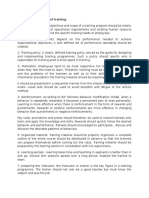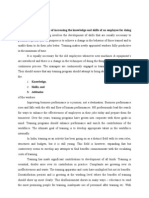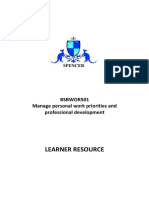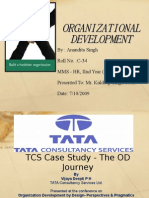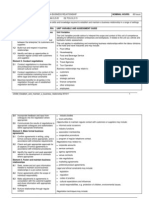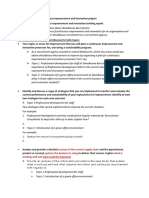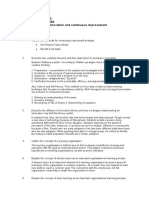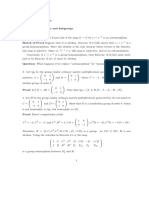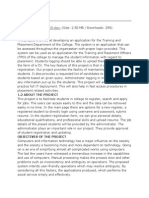Importance of Training
Importance of Training
Uploaded by
raazoo19Copyright:
Available Formats
Importance of Training
Importance of Training
Uploaded by
raazoo19Original Description:
Original Title
Copyright
Available Formats
Share this document
Did you find this document useful?
Is this content inappropriate?
Copyright:
Available Formats
Importance of Training
Importance of Training
Uploaded by
raazoo19Copyright:
Available Formats
Chapter-5
PCMS BBA
HRM
TRAINING
Concept of training
Training is the process of increasing the know ledge & skills for doing a particular job. The purpose of
training is basically to bridge the gap between job requirement & present competence of an employee.
Training is job-oriented, short term & management initiated. Training is required as per the requirement
of Job requirement, with the change in Technology and to make the employee fit for internal mobility.
Training should be distinguished from education training is any process by which the aptitudes, Skills
and abilities of employee, to perform specific job. On the other hand education is the process of
increasing the general knowledge and understanding of employees. Education is person oriented while
training is job-oriented.
The old concept of training as the responsibility of the management has been changed as joint
responsibility of management and the employee.
Importance of Training
1.
2.
3.
4.
5.
6.
7.
8.
9.
A well planned & well executed training program can provide the following advantages.
Higher productivity: Training helps to improve the level of performance. Trained employees perform
better by using better method of work.
Better quality of work: In formal training the best methods are standardized and taught to employees.
Improve the quality of product or service.
Less training period: A systematic training program helps to reduce the time & cost involved in learning.
Employees can more quickly reach the acceptable level of performance. They need not waste their time
& efforts in learning through trial & error.
Cost Reduction: Trained employees make more economical use of materials & machinery. Reduction in
wastage & spoilage together with increase in productivity help in minimize cost of operation.
Reduced supervision: Well-trained employees tend to be self confident & motivate. They need less
guidance & control, Supervisory burden is reduced & the span supervision can be enlarged.
Low Accident rate: Trained personnel adopt the right work method & make use of prescribed safety
advice. The frequency of accident is reduced.
High morale: Proper training can develop the attitudes among employees. Job satisfaction & morale are
improved due to a rise in the earnings & job security of employees. Opportunities for internal promotion
are available to well trained personnel.
Personal Growth: Training enlarges the knowledge & skills of the participant. Well trained personnel can
grow faster in their career. Training prevents obsolescence of Knowledge & skills.
Organizational Climate: A sound training program helps to improve the climate of an organization.
Industrial relations & discipline are improved. Decentralization of authority & participative management
can be introduced. Training helps in reduction of employee turnover & absenteeism which gradually
improve the organization Climate.
Training Process:
The training process consists of the following steps
a) Identifying training Needs: All training activities must be specific needs of the organization & the
individual employees. A training program should be launched only after the training needs are assessed
clearly & specifically. Training needs can be identified through organizational analysis through analysis
of objectives, task and role analysis and manpower analysis. Training to a specific employee is required
to fill the gap between the skills needed for doing a job and the present skill level of employee.
b) Training objectives: Once the training needs are identified, the next step is to set training objectives in
concrete terms & to decide the strategies to be adopted to achieve these objectives.
Chapter-5
c)
d)
e)
f)
g)
PCMS BBA
HRM
Objectives of training express the gap between the present the desired performance level. Training
objectives should be specific, measurable & time-bound outcomes. They can be in terms of skills to be
taught, Changes in behavior or performance result sought
Designing the training program: In order to achieve the training objectives, an appropriate training
policy is necessary. A training policy represents the commitment of top management to employee
training. The suitable nature of training method among OJT, off- the job training, class-room training,
internship training should be choosed. Several methods are used to provide the organization should
choose the suitability per employee capability & cost constraint.
Select trainees & Trainers: In order to make the training fruitful, right kind of trainees & effective
trainers should be selected otherwise they may break the program in between.
Develop budget: As cost is most necessary things for training program, a good cost management should
be made earlier to let the whole procedure go smoothly. Adequate budget is needed to do long duration
training.
Implement Training: As per the earlier informed time the training should be given to the target trainees.
All trainers & trainees should follow the aforesaid schedule of training in order to get the necessary
expectation from it.
Evaluating Training: The outcomes of training should be evaluated. Performance factor can also be
measured. Evaluation result provides feed back to improve current activities & plan future training
programs.
Training Methods & Techniques:
1. O.J.T: In this method the trainee is placed on a regular job & taught the skills necessary to perform the
trainee learns under the guidance and supervision of the superior or an instructor. The trainee learns by
observing & handling the job. It is called learning by doing.
Several methods are used to provide on the job training example Coaching, Job rotation, Job
instruction training.
The main advantage of OJT is that the trainee learns on the actual machine in use & in the real
environment of Job. He gets a feel of the actual job. He is better motivated to learn there is no problem
of transfer of training skill to the job secondly this method is very economical as no additional space
equipments are required for training. In the same time disturbance in learning due to noise of workplace & possible damage to costly equipment & materials are demerits of this method.
2. Vestibule Training: In this method a training centre called vestibule is set up & actual job condition are
duplicated or simulated in It. Expert trainers are employed to provide training with the help of equipment
& machines which are identical with those in used at the works place.
In this method the trainees get enough situations to concentrate to their training & also get the real job
conditions but it is costly method use of additional investment in classroom & equipment.
3. Apprenticeship Training: In this method the trainee learn by working with those already skilled in their
job. Theoretical instruction & practical learning are provided to trainees. This is an "earn when you
learn" Scheme to employees. The duration for apprenticeship varies from job to job- generally from 2 to
5 years. A master worker guides the trainee. The examples are plumbers, electricians, accountants etc.
The main advantage of this method is that the trainee acquires skills which are valuable in the job
market but it is time consuming & most do not keep patience to finish the training.
4. Internship Training: It is joint program of training in which educational institute & business firms
cooperate. The goal of this method is to combine practical experience with classroom-oriented
theoretical knowledge Selected candidates carry on regular studies for the prescribed period. They also
work in some factory or office to acquire practical knowledge & skills. But it
Involves a long time period due to slow process this method of training is used in professional work e.g.
MBBS, CA, Nursing, and Secretaries etc.
5. Class-room training: Under this method, training is provided in company class rooms or in
educational institutions. Lectures, Case studies, group discussions & audio visual aids used to
explain knowledge & skills to the trainees. Classroom training is suitable for teaching concept &
Chapter-5
PCMS BBA
HRM
problem solving skills. It is also useful for orientations & safety training program. Some Companies
maintain their own training institutes for school. Small firms depend on outside schools & course.
Concept of Development
Executive Development is a systematic process of learning & growth by which managerial personnel
gain & apply knowledge, Skills, attitude to manage the work in the organization efficiently and
effectively. Development consists of all the means by which executives learn to improve their behavior
& performance. It is designed to improve the effectiveness of manager in their present job & to prepare
them for higher jobs in future.
Definition: management development includes the process by which managers & executive acquire not
only skills & competency in their present jobs but also capabilities future managerial tasks of increasing
difficulty end scope.
Executive development is a long term process as managerial skill can't be developed overnight & it is on
going & never ending exercise which aims at preparing managers for better performance helping them to
realise their full potential.
Importance
1.
2.
3.
4.
5.
6.
Development is necessary for the following reasons.
It is important to handle the problems of giant & complex organization to face increasing competition.
To prepare the manager ready to perform, manage, control the organizational activities for present and
future date.
It is important as it helps managers to cope with the change of technological & social concept.
Labour management relations are increasingly complex. Executive require new & better skills in union
negotiation, collective bargaining, grievance handling etc. Workers are better education & more aware.
More competent managers are needed to manage the modern workforce.
Management of public utilities, state enterprises & Civic bodies is being professionalized in order to
improve operational efficiency.
No organizational can be successful in the long run without a planned approach to the development of its
managerial persons. In the wood of peter Drucker, an institute that can't produce its own manager will
die. From an overall point of view the ability of an institute to produce manager is more important than
its ability to produce goods efficiently & cheaply".
Methods of Managerial Development
1. On the Job Method
a) Coaching: In this method, the superior guides instruct the trainee as coach. The coach sets mutually
agreed upon goals suggests how to achieve these goals, periodically review the trainees progress &
suggests changes required in behaviors & performance.
Coaching can be effective if the coach is a good communicator, an able motivator & patient listener.
b) Understudy: An Understudy is a person selected & being trained as the heir apparent to assume at a
future time the full duties & responsibilities of the position presently help by his superior. In this way a
fully trained person become available to replace a manager during his long absence or illness, on his
retirement, transfer, promotion or death. The junior is generally assigned tasks which are closely related
to the work in his section & he is deputed to attend executive meetings as a representative of his
superior.
c) Job Rotation: It involves movement or transfer of executives from one position or job to another on
some planned basis. These persons are moved from one managerial position to another
according to a rotation schedule. Position rotation is also called job rotation. The aim is to broaden the
knowledge, skills & outlook of executives. Job rotation is often designed for junior executives.
Chapter-5
PCMS BBA
HRM
d) Planned work assignment: In this method a manager is assigned with work women gives opportunity to
gain experience & develop ability. The work can be project assignment, leadership role or decision
making role.
E) Selective Readings: managing has become a specialize job requiring a close touch with the latest
development un the field. By reading selected professional books & journals, managers can keep in
touch with the latest research findings, theories & techniques in management. Reading current
management literature helps to avoid managerial obsolesces. Selective reading constitutes an individual
self-development program for executives. Many organizations maintain libraries for their executives &
managers are encouraged to continually read & improve their skills.
2. Off the Job Methods:
a. Lectures/ Seminar: these are formally organized talk by an instructor on specific topic. Lectures are
essential when technical or special information of a complex nature is to be provided. These can be
supplemented by discussion case study, demonstrations, audio visual aids & film shows. Lecture method
is a simple way of imparting knowledge to a large no of persons within a short time. It is very useful
when facts concepts, principles, attitudes & problem solving skills are to be taught. More material can be
presented with a given time than by any other method.
Group discussion is the process in which paper is prepared & presented by one or more trainees on the
selected topic which is followed by a critical discussion under the guidance of chairman of the
discussion.
Case study is the method in which a real or hypothetical business problem or situation demanding solution is
presented in writing to the trainees where trainees identify & analyze the problem & suggest the most
appropriate solution.
b. Sensitivity training. Sensitivity training is a group experience designed to provide maximum possible
opportunity for the individuals to expose their behavior, Give & receive feedback, experiment with new
behavior & develop awareness of self & of others. The trainees are brought together in a free & open
environment where participants discuss themselves. The discussion is lightly directed by behavioral
expert who crates the opportunity to express their idea, beliefs & attitudes.
c. Management games: Management or business games are designed to be representative of real life
situations. These are classroom simulation exercises in which teams of individuals complete against one
another or against an environment in order to achieve a given objectives. Management games usually
consists of several teams which represent competing companies. Each team consists of 2 to 6 members.
Teams take decision & attempt to maximize hypothetical profit in the simulated environment finally
result are workout by each team & compared with those of others. Management games are indented to
teach trainees how to take managerial decisions in an integrated manner. The participant learns by
analyzing problems & by making trial & error decisions.
You might also like
- Sumita Oliya Internship ReportDocument20 pagesSumita Oliya Internship Reportraazoo19No ratings yet
- Statistics For Traffic EngineersDocument55 pagesStatistics For Traffic EngineerssaliniNo ratings yet
- BSBLDR403 Student Assessment Tasks V1.0Document29 pagesBSBLDR403 Student Assessment Tasks V1.0Mahamood Faisal100% (1)
- ISTD Paper1 Business Strategy and HRDDocument4 pagesISTD Paper1 Business Strategy and HRDcharuNo ratings yet
- Training and Development at TESCODocument6 pagesTraining and Development at TESCOSiddhant1741991No ratings yet
- Session 2 What Young Children Need 7kDocument35 pagesSession 2 What Young Children Need 7kApril Cathrine Gloria86% (14)
- T & D NotesDocument20 pagesT & D NotesAjay PhalkeNo ratings yet
- Definition of TrainingDocument18 pagesDefinition of TrainingTyagi Munda AnkushNo ratings yet
- R of LDocument33 pagesR of LRaja SekharNo ratings yet
- BSBWOR501 Learner Resource v3.1 (Book)Document54 pagesBSBWOR501 Learner Resource v3.1 (Book)Stacy ParkerNo ratings yet
- Performance ManagementDocument5 pagesPerformance ManagementMohinderSingh50% (4)
- BSBINN301A Promote Innovation in A Team EnvironmentDocument11 pagesBSBINN301A Promote Innovation in A Team EnvironmentSania ALi0% (1)
- Assessment-2 V 1.1Document12 pagesAssessment-2 V 1.1endy jakNo ratings yet
- JawhdgfajsgfasfDocument25 pagesJawhdgfajsgfasfNubia DiazNo ratings yet
- Administrative Skills and Competencies: Yes or NoDocument9 pagesAdministrative Skills and Competencies: Yes or NoannalynNo ratings yet
- Module Summaries Advanced LevelDocument18 pagesModule Summaries Advanced LevelNurali PanjwaniNo ratings yet
- Written AnswersDocument24 pagesWritten AnswersMankamal Preet Singh100% (1)
- BSBLDR502Document3 pagesBSBLDR502Kumail Haider20% (5)
- TrainingDocument31 pagesTrainingNataliaMartianNo ratings yet
- Important - Read This First: PlagiarismDocument13 pagesImportant - Read This First: PlagiarismMonique Marcolin BugeNo ratings yet
- BSBRSK501 Manage Risk Assessment - 1 BackgroundDocument11 pagesBSBRSK501 Manage Risk Assessment - 1 BackgroundBuddha Thapa100% (1)
- Business ResourcesDocument19 pagesBusiness ResourcesShamim Ahmed Mozumder Shakil100% (1)
- Student Name: Subject Code: Due Date: Student ID: Subject NameDocument10 pagesStudent Name: Subject Code: Due Date: Student ID: Subject NameDavis Sagini ArtNo ratings yet
- BSBCUS403 Implement Customer Service Standards - Learner Instruction 1Document10 pagesBSBCUS403 Implement Customer Service Standards - Learner Instruction 1Venta Meylan100% (3)
- HRDDocument33 pagesHRDveenavas15No ratings yet
- Performance AppraisalDocument20 pagesPerformance AppraisalGODBARNo ratings yet
- Assignments Part I Papers of ISTD Diploma Programme, 2012 January BatchDocument20 pagesAssignments Part I Papers of ISTD Diploma Programme, 2012 January Batchrukmanbgh12100% (1)
- Employee Training in NTCDocument15 pagesEmployee Training in NTCशिशिर ढकाल100% (2)
- Organizational Development in TCSDocument39 pagesOrganizational Development in TCSAdv Sailaj Ramachandran NairNo ratings yet
- BSBRSK501 Manage Rish Learner Assessment WorkbookDocument7 pagesBSBRSK501 Manage Rish Learner Assessment WorkbookEvanzelist Ipsita86% (7)
- Performance Appraisal PresentationDocument6 pagesPerformance Appraisal PresentationDolly RamieNo ratings yet
- Assessment II - Business Environment 1 - REVISED T318Document18 pagesAssessment II - Business Environment 1 - REVISED T318iqraNo ratings yet
- Develop Teams & Individuals - Doc3Document40 pagesDevelop Teams & Individuals - Doc3FelekePhiliphos100% (3)
- BSBWOR501: Manage Personal Work Priorities and Professional DevelopmentDocument6 pagesBSBWOR501: Manage Personal Work Priorities and Professional DevelopmentManpreet Kaur50% (2)
- Paramjit Kaur Student Id: S1339 Date:24-05-2021Document6 pagesParamjit Kaur Student Id: S1339 Date:24-05-2021Harkamal singhNo ratings yet
- Induction Guidance NotesDocument4 pagesInduction Guidance NotesBhaskar Rao PNo ratings yet
- CS Establish & Maintain A Bus Relationship 051011Document7 pagesCS Establish & Maintain A Bus Relationship 051011Nette de GuzmanNo ratings yet
- BSBHRM512 Learner 2Document10 pagesBSBHRM512 Learner 2Ashish AcharyaNo ratings yet
- BSBFLM303C Contribute To Effective Workplace - Reading MaterialDocument25 pagesBSBFLM303C Contribute To Effective Workplace - Reading MaterialRodger Phillips67% (3)
- Task 2Document9 pagesTask 2Dibyendu KarmakarNo ratings yet
- Assessment Task 3 ProjectDocument7 pagesAssessment Task 3 ProjectJon AdidNo ratings yet
- BSBSMB406 Manage Small BusinessesDocument14 pagesBSBSMB406 Manage Small BusinessesIbsen Hanoj StockmannNo ratings yet
- BSBLDR803 Partnership Task 1 Akash KaileyDocument18 pagesBSBLDR803 Partnership Task 1 Akash Kaileysuper neoNo ratings yet
- Level 5 Diploma in Human Resource ManagementDocument3 pagesLevel 5 Diploma in Human Resource ManagementGibson100% (1)
- Portfolio in Human Resource ManagementDocument22 pagesPortfolio in Human Resource ManagementErlene LinsanganNo ratings yet
- 2 - Assessment Task 2 Guidelines PDF 1 PDFDocument4 pages2 - Assessment Task 2 Guidelines PDF 1 PDFSusma SahiNo ratings yet
- Myanmar Labour Law (FS - 2019)Document112 pagesMyanmar Labour Law (FS - 2019)zaw khaingNo ratings yet
- Ed Ebreo - Service Excellence WorkshopDocument5 pagesEd Ebreo - Service Excellence WorkshopEdwin EbreoNo ratings yet
- BSBOPS501 Assessment Task 1Document5 pagesBSBOPS501 Assessment Task 1Prem KAEWMALI0% (2)
- Review of Goal Setting TheoryDocument15 pagesReview of Goal Setting TheoryRandula ChandrarathneNo ratings yet
- Learning & Development Strategy 2011 - 2014: Background and IntroductionDocument5 pagesLearning & Development Strategy 2011 - 2014: Background and IntroductionAlan SultanNo ratings yet
- Presentation On MeetingsDocument29 pagesPresentation On Meetingsnidhi agrawalNo ratings yet
- ISTD 2nd-AssignmentDocument40 pagesISTD 2nd-Assignmentmkmatta100% (1)
- BSBWOR502 Task 1 (Final)Document8 pagesBSBWOR502 Task 1 (Final)Rashid Mahmood ArqamNo ratings yet
- Case 9. Manage Stree PresentationDocument35 pagesCase 9. Manage Stree PresentationWael_Barakat_3179No ratings yet
- BSBLDR803 Develop and Cultivate Collaborative Partnerships and RelationshipsDocument57 pagesBSBLDR803 Develop and Cultivate Collaborative Partnerships and RelationshipsSaira BalochNo ratings yet
- BSBADM502 (Teo)Document19 pagesBSBADM502 (Teo)Tee Li MinNo ratings yet
- Faculty Management SystemDocument10 pagesFaculty Management SystemFurqan Syed100% (1)
- Training and Development Notes Unit 2Document16 pagesTraining and Development Notes Unit 2Prabhat ThakurNo ratings yet
- Sha Yee YongDocument17 pagesSha Yee YongJenny YipNo ratings yet
- Human Performance Technology A Complete Guide - 2020 EditionFrom EverandHuman Performance Technology A Complete Guide - 2020 EditionNo ratings yet
- Human Capital Management Plan A Complete Guide - 2020 EditionFrom EverandHuman Capital Management Plan A Complete Guide - 2020 EditionNo ratings yet
- Questionnaire SampleDocument7 pagesQuestionnaire Sampleraazoo19100% (1)
- Motivational Training: Program OutlineDocument1 pageMotivational Training: Program Outlineraazoo19No ratings yet
- HRM Unit 1Document49 pagesHRM Unit 1raazoo19No ratings yet
- Investor'S Preference in Stock Market Participation A Study of Nepalese Retail Investor'SDocument1 pageInvestor'S Preference in Stock Market Participation A Study of Nepalese Retail Investor'Sraazoo19No ratings yet
- 4 Quarter 2074/2075 (14 April 2018 - 16 July 2018) : ST THDocument2 pages4 Quarter 2074/2075 (14 April 2018 - 16 July 2018) : ST THraazoo19No ratings yet
- Negative Motivation Concerns With Influencing The Behavior ofDocument5 pagesNegative Motivation Concerns With Influencing The Behavior ofraazoo19No ratings yet
- HRM Unit 2Document9 pagesHRM Unit 2raazoo19No ratings yet
- HRM 4 UnitDocument10 pagesHRM 4 Unitraazoo19No ratings yet
- HRM NoteDocument60 pagesHRM Noteraazoo19No ratings yet
- SamplingDocument89 pagesSamplingraazoo19No ratings yet
- Meaning and Importance OfresearchDocument19 pagesMeaning and Importance Ofresearchraazoo19No ratings yet
- Unit III Supply Chain DriversDocument13 pagesUnit III Supply Chain Driversraazoo19No ratings yet
- Simple Random 2. Systematic 3. Stratified 4. Cluster 5. Multi-StageDocument9 pagesSimple Random 2. Systematic 3. Stratified 4. Cluster 5. Multi-Stageraazoo19No ratings yet
- Research Method AllDocument90 pagesResearch Method Allraazoo19No ratings yet
- Research Unit FourDocument7 pagesResearch Unit Fourraazoo19No ratings yet
- Functional StrategyDocument2 pagesFunctional Strategyraazoo19No ratings yet
- Small Business Entrepreneurship: The Meaning of Small Business: Small Business Means Small in Operation, EmploymentDocument1 pageSmall Business Entrepreneurship: The Meaning of Small Business: Small Business Means Small in Operation, Employmentraazoo19No ratings yet
- Introduction SlideDocument32 pagesIntroduction Slideraazoo19No ratings yet
- Financial Plan2Document6 pagesFinancial Plan2raazoo19No ratings yet
- The Process of Setting Up A Small BusinessDocument1 pageThe Process of Setting Up A Small Businessraazoo19No ratings yet
- Problems of Small Business: S.no. Parameters Small LargeDocument2 pagesProblems of Small Business: S.no. Parameters Small Largeraazoo19No ratings yet
- Capital Investment Is Low1Document4 pagesCapital Investment Is Low1raazoo19No ratings yet
- Customers Are Always The KingDocument2 pagesCustomers Are Always The Kingraazoo19No ratings yet
- 2nd Sem RoutineDocument1 page2nd Sem Routineraazoo19No ratings yet
- Generation of Active Leaders (GOAL) : Evaluation FormDocument2 pagesGeneration of Active Leaders (GOAL) : Evaluation Formraazoo19No ratings yet
- Asian TQM Final QnsDocument1 pageAsian TQM Final Qnsraazoo19No ratings yet
- TelmisartanDocument4 pagesTelmisartanHanniel MontecalboNo ratings yet
- Class #2 February 18Document8 pagesClass #2 February 18Leoandi lopezNo ratings yet
- Transfer Order LatesDocument265 pagesTransfer Order LatesAaimen abbasNo ratings yet
- Darajar Yayana Part 4 Complete Hausa Novel by Hausanovels001Document42 pagesDarajar Yayana Part 4 Complete Hausa Novel by Hausanovels001bukaraisha91No ratings yet
- RevTeam CodesDocument5 pagesRevTeam CodesMouhamadou Moustapha FayeNo ratings yet
- 1 - Which Device Performs The Function of Determining The Path That Messages Should Take Through Internetworks?Document25 pages1 - Which Device Performs The Function of Determining The Path That Messages Should Take Through Internetworks?mutheeswari1No ratings yet
- The Battle of The FormsDocument4 pagesThe Battle of The FormsMac BrightNo ratings yet
- Lesson 1 & 2 ReviewerDocument4 pagesLesson 1 & 2 Reviewerandreajade.cawaya10No ratings yet
- Sol HungerfordDocument4 pagesSol Hungerfordsinintegral100% (1)
- Chapter 06 - SolutionsDocument9 pagesChapter 06 - SolutionsCaryn RichardsonNo ratings yet
- loveFMD Magazine Issue8Document88 pagesloveFMD Magazine Issue8loveFMDNo ratings yet
- 2 (EDITED) Yap SR V SiaoDocument4 pages2 (EDITED) Yap SR V SiaoRioNo ratings yet
- The Return of The NNNDocument13 pagesThe Return of The NNNAR MalikNo ratings yet
- Greetings & IntroductionsDocument2 pagesGreetings & IntroductionseyemanNo ratings yet
- Role of Children in The Family Buying ProcessDocument27 pagesRole of Children in The Family Buying ProcessriganNo ratings yet
- Jetking Training Cum Placement ProjectDocument114 pagesJetking Training Cum Placement ProjectDakshtaPhulpagarNo ratings yet
- Applied Folklore HandoutDocument114 pagesApplied Folklore HandoutnaboendaluNo ratings yet
- The Prayer of A Traveler: Shaykh Salih Al-FawzanDocument4 pagesThe Prayer of A Traveler: Shaykh Salih Al-FawzanMohammed NabeelNo ratings yet
- TRCT 05Document24 pagesTRCT 05lakshaycool.upesNo ratings yet
- Local Stud DraftDocument2 pagesLocal Stud DraftJeremiahNo ratings yet
- 3 Types of PronounsDocument18 pages3 Types of PronounsJoemeniel S. AmbrocioNo ratings yet
- Boardworks Magnets and ElectromagnetsDocument8 pagesBoardworks Magnets and ElectromagnetsAamina HassanNo ratings yet
- Six Systems - Max MullerDocument524 pagesSix Systems - Max MullerparaisoptptNo ratings yet
- Nicart, Jeric-Vincent C. - Genetics LaboratoryDocument3 pagesNicart, Jeric-Vincent C. - Genetics Laboratoryebenicart0No ratings yet
- Path RikeDocument4 pagesPath RikeSunilKumarNo ratings yet
- China and Africa - BibliographyDocument242 pagesChina and Africa - BibliographyDavid ShinnNo ratings yet
- Report of PPRA 2014 Workshop-Rawalpindi PDFDocument21 pagesReport of PPRA 2014 Workshop-Rawalpindi PDFAamir Jamal GondalNo ratings yet
- Organizational Learning and Knowledge Management: Subject: Professor: Group 8Document29 pagesOrganizational Learning and Knowledge Management: Subject: Professor: Group 8pushkarsingh27100% (1)






